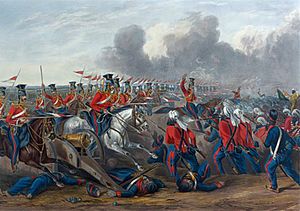Battle of Aliwal
| Battle of Aliwal | |||||||
|---|---|---|---|---|---|---|---|
| Part of First Anglo-Sikh War | |||||||
 Charge of British 16th lancers against Sikh Fauj-i-Ain infantry and artillery. |
|||||||
|
|||||||
| Belligerents | |||||||
|
|
|
||||||
| Commanders and leaders | |||||||
| Sir Harry Smith | Sardar Ranjodh Singh Majithia | ||||||
| Strength | |||||||
| 12,000 30-32 guns |
20,000 69-70 guns |
||||||
| Casualties and losses | |||||||
| 673-850 | 2,000 - 3,000 67 guns |
||||||
The Battle of Aliwal was fought on 28 January 1846 between the British and the Sikhs. The British were led by Sir Harry Smith, while the Sikhs were led by Ranjodh Singh Majithia. The British won a victory which is sometimes regarded as the turning point of the First Anglo-Sikh War.
The First Anglo-Sikh War began six years after the death of Ranjit Singh, who had established the Sikh Empire in the Punjab. The Punjab became increasingly disordered, while the British increased their military forces on their border with the Punjab. Eventually, the increasingly turbulent Sikh Khalsa Army was goaded into crossing the Sutlej River and invading British territory, under leaders who were distrustful of their own troops.
On 21 December and 22 December 1845, the army of the British East India Company commanded by Sir Hugh Gough and the Governor-General of Bengal, Sir Henry Hardinge, fought the bloody Battle of Ferozeshah. The Sikh armies under Vizier Lal Singh and Commander in Chief Tej Singh eventually retreated, but the British army was shaken by its heavy losses. They did not renew hostilities for some weeks, and Hardinge sought to relieve Gough of his command, blaming his tactics for the heavy casualties.
The Sikhs too were temporarily disheartened by the retreats ordered by their commanders. However, they were reinforced by troops who had not yet seen action and moved back across the Sutlej to occupy a bridgehead at Sobraon, while a detachment under Ranjodh Singh Majithia (sometimes transcribed as Runjoor Singh), with 7,000 men and 20 guns, crossed higher up the Sutlej to besiege the British-held fortress of Ludhiana and menace Gough's and Hardinge's supply lines. The British commanders detached a division under Sir Harry Smith to clear this threat to their rear.
...
Wikipedia
